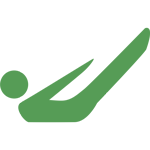Description
About This Video
Transcript
Read Full Transcript
So I have a piece of equipment here that uh, is called the arc. I would say it's a, um, a copy of what I used to call the small barrel, which is just like a spine correctly with much shorter anything, most, anything you can do on the spine correctly can be done in the small barrel and a few little additional things. And I just wanted to share some aspects of this. Variations can be done two different ways. So for example, the hundreds for advanced people, if you place them on the pinnacle of this and you ask them to do the hundreds, it's really an interesting place because if there's any imbalances in the spine, it will start to sink in one direction and this will allow the person to really focus in and staying even on both sides. So lovely place to work into the hundreds.
This is just an idea and then going into roll up, the same thing applies. It almost is like doing roll up on a foam roller because sometimes people wrote one side of swing to the other side and you get instant feedback on what's happening with your spine. And with the right and left side too, the pelvis has one side that's a little bit more protruding than the other. You can really feel this happening. So lovely place to do those two exercises, both roll up in hundred and then really fun is rolling like a ball because it is so interesting because if you roll to one side at all, you roll off the arc and this is nice to play with and usually makes quite a few people laugh in the process. So taking it down a notch, if you were to do the same exercises for beginners or for people who have neck problems, you turn the Ark Sideways.
So hundreds for example with some nice support just for the head and the shoulders allows the back to belong in the person to focus in on their powerhouse and actually stay heavy into the head. So there is no stress at all into the head and the neck and they can really get the powerhouse starting to work for them. So wonderful place to get the support happening. Or if you wanted to work a little bit higher than the legs could be at a different angle. This is very, very individual going into roll up. Often people can't roll all the way down all the way up.
So this allows for that support into the back to the really doing a half Rola and they're getting to focus in on the lumbar spine and possibly get a stretch into the shoulders. But it actually takes a place of a pillow. And what's nice about this is it's more than a pillow. It allows the shoulders to be slightly lifted, so they're starting to work the flexibility, the spine without, um, you know, asking more of their back than it's ready to give them precise. A very, very lovely for older people. Lovely for um, younger people who just have some challenges or just people who want to experience the exercise from a different perspective.
Single like circles is just fabulous. You want to make sure that the hips are in front of the arch as you roll back and then get a nice stable point for the sacred. It's like a hand grabbing the sacred man, pulling it away from the rib cage. An area that tends to be very grippy. And this you really get a beautiful traction which allows the pelvis to be long without being tapped and not quite a complex achievement.
This really is a tool to help get that sense, not just sensation, but actually place the body there so the muscles can start to elongate. So on a basic level, the bottom leg will be bent and then you learn and you can explore. You can literally spend time either on your own or with the client working the range of movement of the hip in the socket without letting the pelvis move around. So right now this is actually providing, I feel like my pelvis is on a complete platform and yet I'm, I'm finding what is the range of movement that I can get with from the leg in the socket as a result to make it more challenging. The leg has to be longer. Now it's working into the hip flexor on the leg that extended on the floor.
Probably not for everybody at the beginning because their pelvis will be too tight and grippy, but for those people that are more advanced, this is a wonderful, wonderful place to get that stretch. Then another stretch can be with the leg down. Again, the sacrum is law. Just a gentle stretch to open out the hip. Same thing. I'll go through this on the other side. Again, I feel like someone's grabbing the base of my spine and pulling it away from my my rib cage and it's such a sense of release. So testing my range of movement with the pelvis anchored and secure to see what, how much can I move this like side to side without rocking in the pelvis and then going into my legs circles without the pelvis moving.
So each side is slightly different and I have to really anchor the pelvis down. I'll go for the reverses well and then taking the leg and lengthening it out to get a lot of length through the hip flexor. And again going through these circles without letting the pelvis rock. But what's nice now is not only am I working on the looseness of the hip socket on with the working leg, I'm actually opening up the whole front of the hip on this leg. It's such a lovely feeling now coming off of the arch, if one leg is in the air for [inaudible] older people or more beginning people, you just push the pelvis out and then you rest the legs down. This is a lovely, lovely place to relax and rest and very nice way to come up.
I will show you the more advanced way in just a minute, but we will move on to rolling like a ball with the leg with the barrel down here. Now a lot of people just clunk back, clunk up if they're beginners. So if you place them still just like this, they have their waist down, they have a moment where they can really work the articulation of the spine down. I'm just moving my hand out of the way so you can see it cause we're working towards that. Bringing the knees in and the head isn't gold, so allowing them to come back and up may allows them to focus into the lower back. That area that usually goes flat. Now looks a little harsh perhaps, but I noticed right now when I'm doing this I have a tendency to be rolling to the left so it's giving me the feedback I need to be able to get myself squared out and rocking and rolling more to the middle, which is such a nice feeling and more intelligent. So moving to the series of five by turning it, working sideways, very good for advanced people or people are really good and strong and understand their technique and want to work to the next level because when you lay yourself out lengthwise you have to stabilize your right and left side or your fall off to one side. So I'm going into my single legs and then my double legs reaching out.
Definitely a balance. If I wanted to challenge myself further or challenge my clients, I would get them to be off the edge of the further off the edge you are, the more challenging it is because if you're not strong in your powerhouse, you will fall down. So let's see, queer, my edges, that's definitely starting to be a workout for me. So if you want to be mean to your advanced students, they will not forget what just happened. And here's my scissors because I can feel how much my trunk is having to hold me and let's see if I can even get through. Oh my goodness. Lower lift. Oh yes. And Oh, that was hard. So that's a fun thing to do. For me. It's hard. It's fun.
And coming into spine stretch forward either facing straight or sideways are both useful. Interestingly enough, if you do it from this side, the sip bones have a little ledge and you can do, if you have instability in the pelvis, you can really feel one sit bone is pressed down or more forward, more back. Again, the feedback loop is much, much more direct and very sophisticated. So for more advanced students they can learn a lot and correct a lot about their own body by working this way. If you have someone who is more of a beginner, it's a great place because the knees can be bent, the feet are lower than the pelvis and it allows them to really get more into the spine and the scoop and they will have more range of movement and feel a lot more relief and benefit from this angle than they would just doing it on the floor where sometimes if you're stiff and you don't have much range of movement, it can be just more of a struggle at the beginning stages coming into open like [inaudible] from the side range again, my two sit bones, I'm just checking the knot. I'm really at the front here to see. I think I'm going to work with my hands here right now, see if I can rock back and rock up.
So this is awesome because I have to really work evenly right left side of my spine and I can feel how they are. I'm getting better every time I'm doing it because one side of the spine is used to taking over, I should say one side of my back, so this may not look dramatic but it's definitely making me work nice and hard. Series of five or this case we did the four. Working with the art from the side is also a lovely addition because again, you can provide the support of the neck and the shoulders which allows the ribs to be down the waist to be long and people with neck problems. People are beginners with lower back issues or rib issues.
This just cradles you into the right shape and gives you all the support you need so you can get the benefits and you can be challenging your core working correctly in your powerhouse, but actually resting the neck. Such a lovely place to give your client all these exercises without having them strain in the cervical spine. It's really fabulous. Same goes for scissors or straight like single, straight leg stretches and then lower lift. Same thing again. The head is resting, the upper back is resting, the stomach is working and the lower back is being kept long and is not allowed to arch because of the way that you're being cradle by the spine, by the the the arc after get used to this name, I'm used to calling it the small barrel, so from here again, spine stretch forward can be done like this sitting nicely. Your client will feel pretty safe here. If they're super stiff, you could put a moon box between their legs so they have someone to bend down towards and get a bit of a stretch.
Most people probably can really find how to create that seeker, how to ground into the powerhouse and then how to reach forward because they have so much support under the pelvis to help get them there and feel safe at the same time. Nice thing that can be done here is also a hip stretch with one leg extended bending over. Again, a lot of people are not loose as like I am. I happened to have spent most of my life stretching, so I would have a lot more range of movement. But for people who are stiffer, this can be a blessing because they can actually get the benefit of a stretch here into areas of the body. They need to move that sometimes they're just too tight to get there and get that release. It will give them so much benefit, um, to release their body. So let me see if there's anything else I can think up.
There's a lot that can be done on this, but for now, I hope this adds you. Repertoire gives you things to do both for advanced people and beginners. And I hope you have a lot of fun with it. Thank you.
Comments
Hope this helps?
First of all, it states that this class is 20 mins (when, in fact, it is FIFTEEN minutes); Secondly, you state it is a Moderate workout (when, in fact, it is INSTRUCTIONAL ONLY) last but not least - you claim it is a mat workout (when in fact, you need the plastic arc!!!). I can't think of anything you DID get correct in the description of this class except for the fact that it's taught by Niedra Gabriel. I had TWENTY minutes of time during my day and wanted a strengthening/moderate MAT class and I get this instead. PLEASE check these classes and get ALL the facts straight before listing them on the home page. Thanks
Hope you find a GOOD workout to make up for this somewhere on Pilates Anytime.
You need to be a subscriber to post a comment.
Please Log In or Create an Account to start your free trial.













